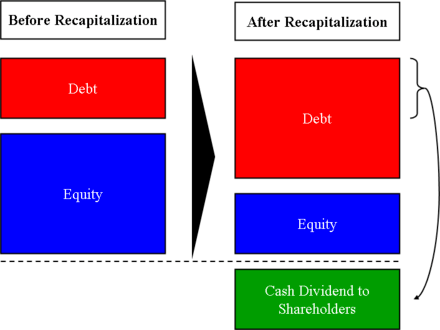Dividend recapitalization

A dividend recapitalization (often referred to as a dividend recap) in finance is a type of leveraged recapitalization in which a payment is made to shareholders. As opposed to a typical dividend which is paid regularly from the company's earnings, a dividend recapitalization occurs when a company raises debt —e.g. by issuing bonds to fund the dividend.
These types of recapitalization can be minor adjustments to the capital structure of the company, or can be large changes involving a change in the power structure as well. As with other leveraged transactions, if a firm cannot make its debt payments, meet its loan covenants or rollover its debt it enters financial distress which often leads to bankruptcy. Therefore, the additional debt burden of a leveraged recapitalization makes a firm more vulnerable to unexpected business problems including recessions and financial crises.
Typically a dividend recapitalization will be pursued when the equity investors are seeking to realize value from a private company but do not want to sell their interest in the business.
An example
In their relatively brief period of management of Hostess Brands, maker of Twinkie brand snack cakes and other products, Apollo Global Management and C. Dean Metropoulos and Company added leverage and took a $900 million dividend, "the third largest of 2015" in the private equity industry.[1]
See also
References
- ↑ Corkery, Michael, and Ben Protess, "How the Twinkie Made the Super-Rich Even Richer", New York Times, December 10, 2016. Retrieved 2016-12-11.
- Dividend Recapitalizations: Cash Alternatives for Private Equity. The Journal Record, November 29, 2010
- Profits for Buyout Firms as Company Debt Soared. New York Times, October 4, 2009
- Private Equity Thrives Again, but Dark Shadows Loom. New York Times, September 29, 2010

